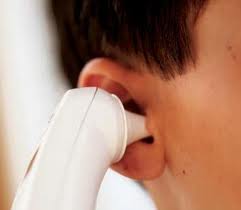 Swimmer’s ear is another term to describe outer ear canal infection or otitis external. Since this condition frequently occurs to people who swim a lot, it is also called swimmer’s ears. Actually the infection can happen in any situation causing a moist environment of the ear canal. A moist environment aids bacterial growth infecting the skin. Another predisposing factor to get an ear infection is when there is an irritation of the skin. Putting fingers, cotton swabs or other objects in your ears also can lead to an ear infection by damaging the thin layer of skin lining the ear canal, making it a port of entry for bacteria.
Swimmer’s ear is another term to describe outer ear canal infection or otitis external. Since this condition frequently occurs to people who swim a lot, it is also called swimmer’s ears. Actually the infection can happen in any situation causing a moist environment of the ear canal. A moist environment aids bacterial growth infecting the skin. Another predisposing factor to get an ear infection is when there is an irritation of the skin. Putting fingers, cotton swabs or other objects in your ears also can lead to an ear infection by damaging the thin layer of skin lining the ear canal, making it a port of entry for bacteria.
The most common bacteria responsible for outer ear infection are Staphylococcus aureus and Pseudomonas aeruginosa. Other bacteria are less common. In a minority of cases (less than 10%), a fungus is the cause of swimmer’s ear.
Some factors that may increase your risk of swimmer’s ear include:
- Swimming
- Swimming in water with elevated bacteria levels, such as a lake rather than a well-maintained pool
- A narrow ear canal – for example, in a child – that can more easily trap water
- Excessive earwax production
- Aggressive cleaning of the ear canal with cotton swabs or other objects
- Use of devices such as headphones, a hearing aid or a swim cap
- Skin allergies or irritation from jewelry, hair spray or hair dyes
Symptoms
The main complaint of someone with swimmer’s ear is pain. Others may also complain of itchiness. The ear itself might look red and in severe cases; the canal may be swollen shut. There can be ear discharge; this should be differentiated with middle ear infection which has a different treatment. The swelling of the canal may cause hearing loss, ringing in the ear and dizziness or vertigo. Some people also may complain of a bubbly sensation inside the ear. Usually there is no fever.
Going to the doctor
There are many over-the-counter (OTC) ear drops and pain tablets which may help relieve mild ear infection, but for moderate to severe cases, these OTC’s are usually not sufficient and you will need to consult a doctor.
Your doctor will perform an otoscope examination, using a special ear magnifying device to see inside the ear canal. Ideally, the doctor should be able to examine up to the ear drums, but when the swelling or pain is unbearable, this is not always possible. The doctor also might perform irrigation or suctioning to clean any debris or wax. These matters can block the ear canal retaining water behind it and become a source of further infection.
You will be given some antibiotic ear drops, sometimes your doctor will also insert a small foam wick into the swollen ear to help the medication pass all through the ear canal.
Prevention
Use of shower caps while bathing and earplugs while swimming will help keep water out of the ear canal. The best earplugs are often soft balls of special wax. The wax can be purchased at BIMC and most pharmacies. Simply roll a small ball of wax in your hands and press it into the outer ear.
Instill ear drops which will dry the ear canal after water exposure.
Avoid placing objects in the ear that can scrape or scratch the skin of the canal because this may cause an infection.











